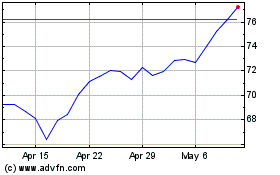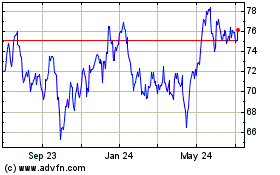By Rebecca Smith
California regulators and utility executives are staring down a
natural-gas shortage in the Los Angeles area that could trigger up
to two weeks of electrical blackouts this summer.
The state's electric grid operator warned Friday that it may
call for emergency reductions in electricity use on Monday and
Tuesday, when a heat wave in Southern California is expected to
push up demand for air conditioning. Without conservation,
officials fear power plants could run out of fuel and trigger
rolling blackouts.
Though the U.S. is awash in natural gas, the L.A. region is
short of the fuel due to the massive gas leak last winter at the
state's largest underground gas-storage facility, Aliso Canyon, an
event that displaced thousands of people in the nearby Porter Ranch
neighborhood.
Southern California is vulnerable to energy disruptions because
it relies on a complex web of electric transmission lines, gas
pipelines and gas storage facilities -- all running like clockwork
-- to get enough electricity. If any piece is disabled, it can mean
electricity shortages. Gas is the state's chief fuel for power
generation, not coal.
But the pipelines can only bring in about 3 billion cubic feet
of working gas a day into Southern California, below the daily
demand, which gets as high as 5.7 billion cubic feet.
An analysis by California's energy agencies said the Los Angeles
area could suffer localized blackouts on as many as 14 days this
summer, unless measures are able to blunt the effect of the gas
reduction.
With summer arriving Monday, regulators and utility executives
are taking emergency actions. They have identified 18 relief
measures, including better coordination of maintenance for gas
pipelines and electrical transmission lines, so vital resources
aren't down when they are needed most.
Regulators have also given utilities permission to line up
unconventional resources, like battery storage of electricity, to
take pressure off gas-generating plants. Solar water heating is
expected to receive a push in coming months, too.
Michael Picker, president of the California Public Utilities
Commission, said the state is making progress on measures to avoid
summer problems in L.A., but he remains concerned that the shortage
could flare up in winter, when demand for the fuel is biggest.
"I'm still plenty scared about winter," Mr. Picker said.
Marcie Edwards, general manager of the Los Angeles Department of
Water and Power, the nation's biggest municipal utility, said she
is signing contracts for space on electrical transmission lines to
import more electricity because she fears she won't be able to get
enough natural gas to keep power plants running.
Ms. Edwards is critical of the region's biggest gas utility,
Southern California Gas Co., the owner of Aliso Canyon, for passing
the buck to electric utilities to solve the gas shortage problem.
She said more should be done to encourage consumers to conserve gas
and leave fuel for power generation.
"If people had the choice of getting electricity or gas, I think
I know which they'd prefer," Ms. Edwards said.
SoCal Gas said it is encouraging all forms of energy
conservation though an $11 million outreach effort and is intent on
returning the Aliso Canyon facility to service by late summer.
Though the Aliso Canyon leak was fixed in February, the facility
in Los Angeles County remains out of commission while more than a
hundred wells undergo a battery of tests to see if they contain
hidden defects. It is one of nearly 400 gas-storage facilities in
the U.S. that occupy depleted oil fields, aquifers or underground
salt caverns.
Mr. Picker said the leak has forced state officials to
reconsider the state's dependence on gas and could result in a
permanent reduction in the amount of gas stored in the state. He
added that other underground storage facilities face more rigorous
testing that could result in more wells being removed from
operation, cutting overall storage capabilities.
"For planning purposes, I'm assuming Aliso Canyon never comes
back," he said. "That's the worst-case scenario, so it's what we
need to plan for."
As many as 8,000 Porter Ranch residents had to be relocated at
the gas company's expense during the leak, which lasted from
October to February.
Although most have returned home, some are refusing until their
residences are scrubbed clean of leak residue. In early June, SoCal
Gas, a unit of Sempra Energy, said it had lined up environmental
cleaning firms to remove contamination, following protocols
developed by the Los Angeles Department of Health.
Mark Morris, vice president of Save Porter Ranch, an
organization formed before the leak to fight oil drilling in the
area, said residents want Aliso Canyon shut down for good.
Few believe the warnings of potential blackouts, he added,
saying the last time the state saw such events was during the
California energy crisis of 2000-2001 and "it was caused by Enron
and market manipulation, not real shortages."
Write to Rebecca Smith at rebecca.smith@wsj.com
(END) Dow Jones Newswires
June 19, 2016 16:47 ET (20:47 GMT)
Copyright (c) 2016 Dow Jones & Company, Inc.
Sempra (NYSE:SRE)
Historical Stock Chart
From Mar 2024 to Apr 2024

Sempra (NYSE:SRE)
Historical Stock Chart
From Apr 2023 to Apr 2024
